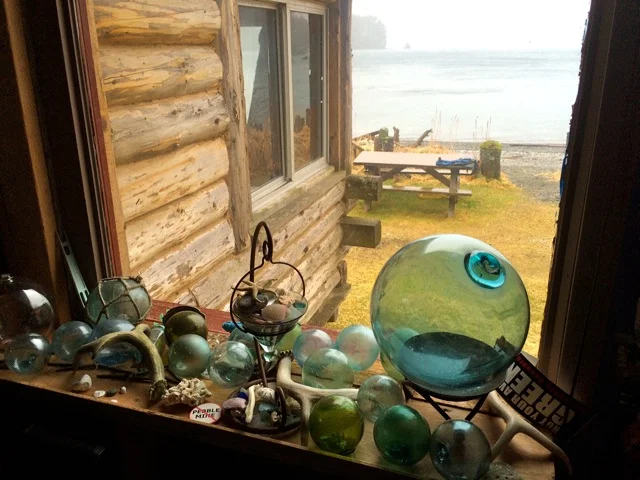Alaska was a tumultuous place during the first two years of World War II. The Territory, like the rest of the nation, was caught off guard by the attacks at Pearl Harbor and the subsequent capture of Kiska and Attu. Following these attacks, there was both a scrambling and influx of people as the military embarked on the Aleutian Campaign. Alaska’s Japanese residents were sent to concentration camps down south, Unangan villagers were taken via transit ships to decaying canneries in Southeast Alaska, 150,000 troops passed through the territory, and the ground was broken on 300 or so military installations, all within those first two years.
War affected remote regions across the state, including Excursion Inlet, which is on the north shore of Icy Strait in northern Southeast Alaska. One of the military installations constructed during the Aleutian Campaign was a top secret shipment facility built right next to the cannery in Excursion Inlet. The so-called Alaska Barge Terminal was meant to ease wartime transportation issues. At the beginning of the war, there were not enough large barges or vessels to properly outfit the military installations on the Aleutian front. With the Alaska Barge Terminal, the military intended to use smaller watercraft to ship materials and people up the Inside Passage to Excursion Inlet. At the terminal, the materials would be loaded on oceangoing barges and then shipped across the Gulf of Alaska.
The military selected the land adjacent to the Astoria and Puget Sound Packing Co. cannery as the site of the trans-shipment port. This cannery, now owned by Ocean Beauty and referred to by the initials XIP, was constructed in 1908, just up the bay from another cannery that was built that very year.
The Excursion Inlet cannery during the summer of 2017.
The military commandeered a portion of the cannery’s property and started filling the tidelands in August of 1942. Over 2700 civilian contractors joined over 800 Army personnel to construct the massive facility. When it was finished, the barge terminal included housing and mess hall facilities to accommodate 260 officers and 4,400 enlisted men. A 3.4 million gallon tank farm was installed, which was intended to fuel nine ocean-going vessels, six barges, two ammunition ships, and two tankers.
Tragically, this top-of-the-line facility was under construction not far from Funter Bay, where villagers from the Pribilofs were sick, hungry, and poorly-housed in the decrepit cannery that constituted their so-called “duration camp.”
The supposed top-secret facility was not much of a secret to the fishermen and cannery workers who labored next door. The seafood industry, too, was mightily impacted by the wartime scramble. There was a shortage of shipping capacity, “floating equipment” (aka vessels), and workers during the war. The most valuable employees were granted a draft deferment, but military matters took precedence over the shipping of people, equipment and fish to and from Alaska. Hundreds of private fishing and processing vessels were requisitioned for the war effort, and this sometimes included the captain and crew. It was an ongoing struggle to procure the materials, people, and transportation required to fish and process Alaskan salmon.
Canned salmon was considered an essential item for feeding servicemen overseas and Americans on rations. In order to fish and process salmon within an active war zone, the federal government instituted a so-called Concentration Plan. With this plan, the Secretary of the Interior determined how many canning lines could be in operation in any given fishing district. “Nucleus” plants were to process the salmon for a fishing area, sharing fishing effort, shipping capacity, and employees with the neighboring plants that were put out of commission. The Concentration Plan produced the salmon pack using the least amount of employees and transportation-related resources. In Excursion Inlet, the Astoria and Puget Sound Packing Co. jointly packed their fish with the neighboring Pacific American Fisheries Plant.
In the fall of 1943, after the cannery had shipped its pack south, the frenetic energy of the trans-shipment port too had gone quiet. The US had retaken Kiska and Attu, rendering this multi-million dollar facility obsolete. It was never used; the War Department declared the 630 acre site as surplus.
In June of 1944, 700 German prisoners of war arrived at Excursion Inlet, sent to salvage the buildings and materials used for the boondoggle. In the few months they spent at the facility, they were able to salvage about twelve million board feet of lumber. Several POWs reportedly tried to escape, but soon realized that there was nowhere to go.
Excursion Inlet plant manager Tom Marshall stands within the museum that he developed on site. The sign next to him shows the cannery's owners over the years.
Tom Marshall, Excursion Inlet plant manager, created a small museum at the cannery. Within, visitors can find plats of the barge terminal, photos of the POWs, and other relics from the cannery’s past.


